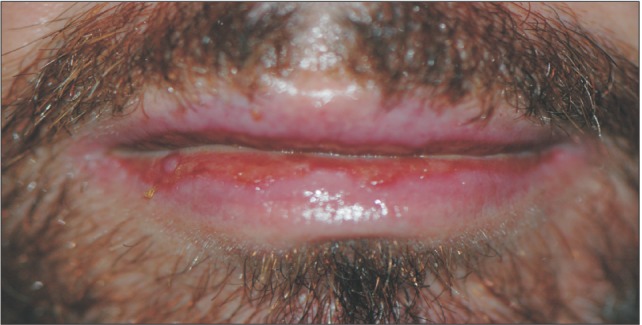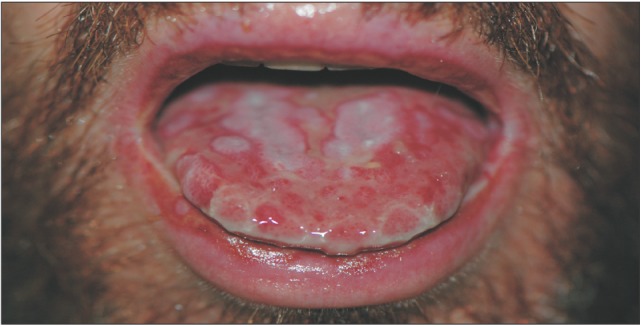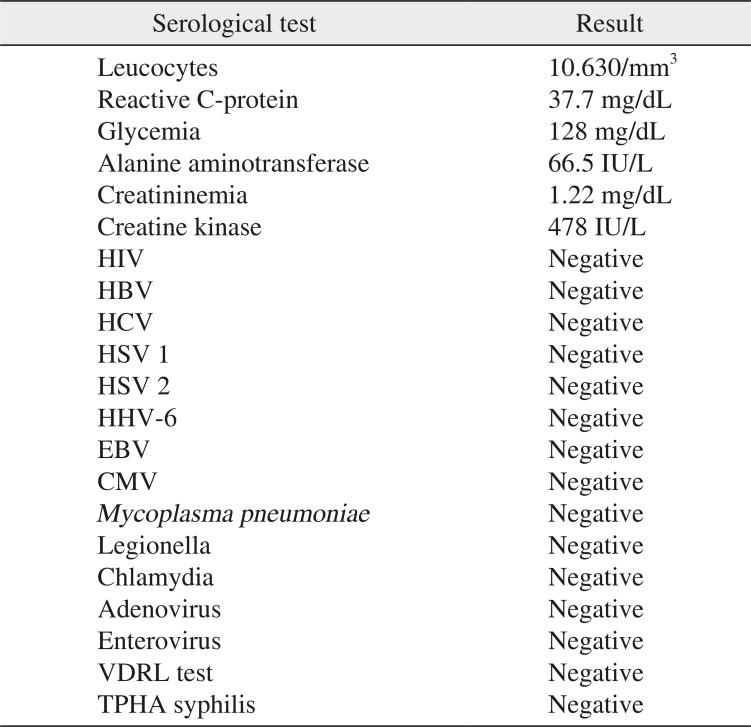Abstract
Stevens-Johnson syndrome (SJS) is characterized by mucocutaneous tenderness and typical hemorrhagic erosions, erythema and epidermal detachment presenting as blisters and areas of denuded skin. SJS is often observed after drug use as well as after bacterial or viral infections. Several drugs are at high risk of inducing SJS, but there are no cases in the English literature regarding anabolic steroid use triggering SJS. In our paper, we describe a case in which use of anabolic androgenic steroids (AAS) was associated with SJS. The patient participated in competitive body-building and regularly took variable doses of AAS. Initial symptoms (headache, weakness, pharyngodynia, and fever) were ignored. After a week he presented to the Emergency Department with a burning sensation on the mouth, lips, and eyes. Painful, erythematous, maculopapular, and vesicular lesions appeared all over the body, including on the genitals. During hospitalization, he also developed a cardiac complication. The patient had not taken any drugs except AAS.
Stevens-Johnson syndrome (SJS) is an acute hypersensitivity reaction involving the skin and mucous membranes, first described in 1922 by Stevens and Johnson1 in two children with purpuric skin macules, stomatitis associated with widespread necrosis of the oral and peri-oral mucosa and severe purulent conjunctivitis.
The extent of skin/mucosal involvement distinguishes SJS from erythema multiformis (EM), which has the same etiology, but the lesions (small erythematous areas) are confined to the skin only. These particular manifestations are often observed after bacterial or viral infections, as well as after drug use. SJS is more severe than EM, having a protracted course that in the worst cases may lead to death (5% of cases). Mortality is considerably higher (up to 70% of cases) when more than 30% of the body surface area is involved. Another variant was first described in 1956 by Lyell2, who described four patients with skin lesions resembling burns, dubbed toxic epidermal necrolysis (TEN)3. In the years after publication of Lyell's article, many cases of TEN were reported and it became clear that TEN could be induced by the same etiological agents as EM, namely infection and/or drug use. The drugs most commonly implicated are antibacterial agents (macrolides, cephalosporin, tetracyclin, sulfamides), antiepileptics (lamotrigine, carbamazepin), gout medication (allopurinol) and anti-retroviral agents (nevirapin).
SJS and TEN are considered variants of severe epidermolytic reactions that differ in the degree of involvement of the skin surface. SJS is associated with epidermal detachment of <10% of the skin surface, whereas TEN is diagnosed when >30% of the skin surface is involved. Forms with skin detachment of 10% to 30% of the body surface are regarded as overlapping forms4. The degree of skin involvement is a major prognostic factor; only necrotic or already detached skin (boils, erosions) and skin positive for Nikolsky sign should be counted when assessing the body area involved.
The initial symptoms of SJS are almost always aspecific: fever, myalgia, arthralgia and headache, then sore throat, odynophagia and burning eyes, followed several days later by early skin lesions in the form of erythematous rosettes. These may become necrotic, forming erosions, ulcers and large areas of epidermal detachment (severe skin manifestations). In the absence of epidermal detachment, Nikolsky sign can be tested by applying shear pressure to different skin areas. This sign is not specific for TEN/SJS as may also be positive in cases of bullous skin diseases.
The presternal region of the chest and the face as well as palmar and plantar regions are usually the first affected. Oral mucosal, ocular and/or genital involvement occurs in 90% of patients. In some cases the respiratory and gastrointestinal tracts are also involved. Eye involvement is frequent and includes palpebral edema, conjunctivitis, lacrimation, corneal ulcers with pseudomembranes and crusts and purulent eye secretions, which in severe cases may lead to scarring (synechia). However, the severity of acute eye manifestations is not usually predictive of later eye complications5.
Herein we report a case of SJS in a healthy young adult who regularly abused anabolic steroids for competitive bodybuilding.
A 41-year-old male presented at the Emergency Department with a burning sensation of the mouth and eyes, pharyngodynia, weakness, fever, tachycardia, headache, cough, and generalized malaise. The patient had participated in competitive body-building for approximately 20 years, trained daily and regularly took doses of anabolic androgenic steroids (AAS). The patient was not on any other medications or drugs except AAS. The androgen dose was impossible to determine because it was obtained illicitly.
Twelve hours after the last injection of steroids (drostanolone propionate, stanazol, and metenolone enantate), he experienced rapid deterioration: fever and erythematous rosettes appeared initially around the injection site and almost simultaneously on the palmar and plantar regions, later spreading to the trunk and the base of the lower limbs. Painful erythematous maculopapular and vesicular lesions appeared all over the body, including the genitals and oral mucosa. The patient also experienced conjunctival edema and photophobia. Fibroscopic examination revealed extensive involvement of the nasal mucosa (ulcerations and crusts) and also of the oropharyngeal mucosa (pseudomembranes), whereas the laryngeal area was spared.(Fig. 1, 2) Chest radiography and microbiological analysis excluded Mycoplasma pneumoniae infection. During hospitalization, the patient developed sudden cardiac arrhythmia with atrial fibrillation. Initial attempts to regularize heart rate with intravenous (IV) amiodarone (150 mg in 100 mL glucosate in 2 hours, followed by a further 900 mg in 24 hours) failed. Finally, electrical cardioversion was performed and was successful.
During hospital admission, the patient was also treated with systemic glucocorticoids (IV 40 mg methylprednisolone in 100 mL 5% glucosate every 24 hours for 6 days, then 20 mg methylprednisolone for 5 days, and finally 10 mg methylprednisolone for 4 days), an antithrombotic (subcutaneous enoxaparin 4,000 IU/day for 1 month) and was administered enteral nutrition through a nasogastric tube. For oral hygiene, mouthwash containing chlorhexidine digluconate 0.2% was used at least three times a day. His condition slowly improved and he was discharged on day 23 in good general health. Only minor conjunctival ulcers, which were treated by specialists after discharge, persisted.
SJS is an acute hypersensitivity reaction involving the skin and mucous membranes. The etiological agent that triggered the immune reaction is often unclear.
SJS may be triggered by numerous agents, particularly bacteria and viruses, immune conditions, non-infectious agents such as food additives or chemicals (benzoates and nitrobenzene) and drugs6. Common infections associated with SJS are herpes simplex virus and M. pneumoniae. Other pathogens associated with SSJ include Mycobacterium tuberculosis, Group A Streptococcus , hepatitis B virus, Epstein-Barr virus, enteroviruses and Yesinia enterocolitica7. In our case, all serological tests excluded an infectious cause.(Table 1)
Drug ingestion tends to trigger SJS, including of antibacterial agents (macrolides, cephalosporin, tetracycline, sulfamides), antiepileptics (lamotrigine, carbamazepin), gout medication (allopurinol), anti-retroviral agents (nevirapin) and, less frequently, nonsteroidal anti-inflammatory drugs (ketoprofen, ibuprofen). AAS have not previously been included among high-risk drugs1.
AAS were created in 1930 for hormone replacement in a patient with hypogonadism, impotence, infertility, growth retardation, cryptorchidism and eunuchoidism. Nowadays, however, many athletes, especially body-builders, exploit AAS to promote muscle development. The most widely used molecules are testosterone, nandrolone, metandrostenolone, and stanazol8910.
Skin reactions to drugs are the most commonly reported adverse events. The most common clinical patterns are SJS (32%), exanthematous drug eruptions (24.5%), and TEN (11%)11.
The pathogenic mechanism of SJS is tissue damage caused by precipitation of soluble immune complexes, which are produced rapidly and overabundantly in the peripheral circulation. The mechanism of excess production of antibodies to viral, bacterial and pharmacological antigens may be related to genetic factors, but is not yet clear.
Many studies have been conducted on genetics and drug hypersensitivity. An important association between human leucocyte antigen (HLA) and carbamazepin was discovered by Chung et al.12 for the genotype HLA-B 1502. Another association between the HLA genotype and SJS/TEN was reported by the same author for allopurinol: 100% of Han Chinese, an ethnic group native to east Asia, experienced adverse reactions to allopurinol, and all were HLA-B*5801 positive13.
To minimize the risk of developing tolerance, athletes take a cocktail of AAS14. We could not determine the dose of AAS because our patient was taking a cocktail of different molecules purchased on the internet.
The initial symptoms of SJS are almost always aspecific and the clinical presentation may mimic different oral inflammatory diseases. SJS can be difficult to differentiate from vesciculobullous disorders such as bullous autoimmune diseases (pemphigus/pemphigoid), viral stomatitides, Beçhet syndrome, Crohn's disease or staphylococcal scalded skin syndrome15. Features more suggestive of SJS are:
The acute and/or chronic effects of AAS depend on androgen type, dose, duration of treatment, sex and individual genetic susceptibility. Harmful effects of steroid abuse may manifest many years after cessation of use. AAS may also depress the immune system and increase sensitivity to infections101617. Abuse of AAS has also been linked to arrhythmia and sudden cardiac death; considering this, the atrial fibrillation observed in our patient may have been related to AAS use18.
Employing the Naranjo adverse drug reaction (ADR) probability scale, the association between AAS intake and SJS was confirmed.
There are no specific diagnostic tests for SJS, but the diagnosis is supported by tissue biopsy and exclusion of other causes through microbial cultures from blood or serum (for example herpes simplex virus and mycoplasma serology). Furthermore, histologic examination and immunostaining often show intraepithelial edema and spongiosis early on, with satellite cell necrosis and vacuolar degeneration of the basement membrane zone15.
In cases of SJS, any drugs being taken should be identified and stopped and/or relevant infections treated. SJS is a life-threatening condition very similar to burns: supportive care (enteral nutrition via nasogastric tube and IV glucosate) is an essential part of therapy because the patient can experience rapid dehydration. Systemic corticosteroids are the standard treatment for limiting the inflammatory response, but in patient with a history of infectious diseases, there are associated risks. There is insufficient evidence to recommend the routine use of high-dose IV immunoglobulins.
References
1. Stevens AM, Johnson FC. A new eruptive fever associated with stomatitis and ophthalmia; report of two cases in children. Am J Dis Child. 1922; 24:526–533.
2. Lyell A. Toxic epidermal necrolysis: an eruption resembling scalding of the skin. Br J Dermatol. 1956; 68:355–361. PMID: 13374196.

3. Roujeau JC. Stevens-Johnson syndrome and toxic epidermal necrolysis are severity variants of the same disease which differs from erythema multiforme. J Dermatol. 1997; 24:726–729. PMID: 9433029.

4. Bastuji-Garin S, Rzany B, Stern RS, Shear NH, Naldi L, Roujeau JC. Clinical classification of cases of toxic epidermal necrolysis, Stevens-Johnson syndrome, and erythema multiforme. Arch Dermatol. 1993; 129:92–96. PMID: 8420497.

5. Yip LW, Thong BY, Lim J, Tan AW, Wong HB, Handa S, et al. Ocular manifestations and complications of Stevens-Johnson syndrome and toxic epidermal necrolysis: an Asian series. Allergy. 2007; 62:527–531. PMID: 17313402.

6. Sargenti Neto S, de Paulo LF, Rosa RR, Durighetto AF. Stevens-Johnson syndrome: an oral viewpoint. Int J Pediatr Otorhinolaryngol. 2013; 77:284–286. PMID: 23149180.

7. Sawant SP, Amin AS. Mycoplasma pneumoniae associated Stevens-Johnson syndrome in an eight-year-old girl. Pediatr Infect Dis J. 2013; 5:13–15.
8. Basaria S. Androgen abuse in athletes: detection and consequences. J Clin Endocrinol Metab. 2010; 95:1533–1543. PMID: 20139230.

10. Fineschi V. Anabolic androgenic steroids (AAS) as doping agents: chemical structures, metabolism, cellular responses, physiological and pathological effects. Mini Rev Med Chem. 2011; 11:359–361. PMID: 21443515.
11. Mokhtari F, Nikyar Z, Naeini BA, Esfahani AA, Rahmani S. Adverse cutaneous drug reactions: eight year assessment in hospitalized patients. J Res Med Sci. 2014; 19:720–725. PMID: 25422656.
12. Chung WH, Hung SI, Hong HS, Hsih MS, Yang LC, Ho HC, et al. Medical genetics: a marker for Stevens-Johnson syndrome. Nature. 2004; 428:486. PMID: 15057820.
13. Hung SI, Chung WH, Liou LB, Chu CC, Lin M, Huang HP, et al. HLA-B*5801 allele as a genetic marker for severe cutaneous adverse reactions caused by allopurinol. Proc Natl Acad Sci U S A. 2005; 102:4134–4139. PMID: 15743917.
14. Fineschi V, Riezzo I, Centini F, Silingardi E, Licata M, Beduschi G, et al. Sudden cardiac death during anabolic steroid abuse: morphologic and toxicologic findings in two fatal cases of bodybuilders. Int J Legal Med. 2007; 121:48–53. PMID: 16292586.

15. Scully C, Bagan J. Oral mucosal diseases: erythema multiforme. Br J Oral Maxillofac Surg. 2008; 46:90–95. PMID: 17767983.

16. van Amsterdam J, Opperhuizen A, Hartgens F. Adverse health effects of anabolic-androgenic steroids. Regul Toxicol Pharmacol. 2010; 57:117–123. PMID: 20153798.

17. Turillazzi E, Perilli G, Di Paolo M, Neri M, Riezzo I, Fineschi V. Side effects of AAS abuse: an overview. Mini Rev Med Chem. 2011; 11:374–389. PMID: 21443513.

18. Di Paolo M, Agozzino M, Toni C, Luciani AB, Molendini L, Scaglione M, et al. Sudden anabolic steroid abuse-related death in athletes. Int J Cardiol. 2007; 114:114–117. PMID: 16364470.

Fig. 1
Labial lesions in patient with Stevens-Johnson syndrome. Diffuse erosions of lip: limit oral intake because extremely painful.

Fig. 2
Lesions of oral mucosa. Painful, erythematous, ulcerative lesions of the oral mucosa with crusts and pseudomembranes are typical lesions of Stevens-Johnson syndrome.

Table 1
Blood chemistry and microbiological tests1

(HIV: human immunodeficiency virus, HBV: hepatitis B virus, HCV: hepatitis C virus, HSV 1: herpes simplex virus 1, HSV 2: herpes simplex virus 2, HHV-6: human herpes virus 6, EBV: Epstein-Barr virus, CMV: cytomegalovirus, VDRL: venereal disease research laboratory, TPHA: treponema pallidum haemoagglutination assay)
1Anomalous values in routine blood chemistry; microbiological tests excluded an infectious cause.




 PDF
PDF ePub
ePub Citation
Citation Print
Print



 XML Download
XML Download